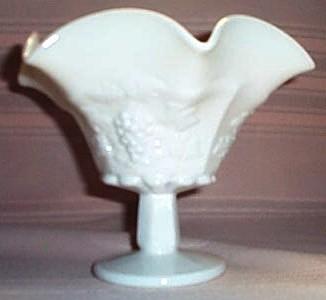National Depression Glass Association
Preserving America's Glass Manufacturing Heritage
Westmoreland's Paneled Grape
by Christine Nagy
The Westmoreland Glass Company’s Paneled Grape pattern was
their most popular line. It started producing it in the late
1940’s and continued to produce this pattern in milk glass
until it’s closing in 1985. The pattern was copied from an
earlier pattern, produced by the Kokomo Glass Company, who produced
this pattern in crystal and crystal with applied colors to the
leaves and grapes. The crystal often had a yellow tinge and the
colors wore quickly, as they were not fired  on. The mold lines were
also not polished. Kokomo produced this line until 1903. The
factory burned in 1905 and it is believed the molds were sold to
Westmoreland, either by Kokomo or the DC Jenkins Company, which
purchased the property.
on. The mold lines were
also not polished. Kokomo produced this line until 1903. The
factory burned in 1905 and it is believed the molds were sold to
Westmoreland, either by Kokomo or the DC Jenkins Company, which
purchased the property.
The first piece produced was the 8 ounce goblet, and since it proved profitable, the company added additional pieces. The pattern became very popular and soon a whole dinner service was available. There were dinner, luncheon and bread and butter plates, cups and saucers, sherbets, tumblers, and other sizes of goblets. Serving pieces were also added, and a variety of vases, epergnes, punch bowl with liner and cups, and more. Some of the rare pieces in the Paneled Grape pattern are the 10 and 14 inch shallow bowls, the lipped epergne, the oblong herb bowl, canisters, punch sets, the fireside basket and lighter.
In 1963, the pattern was changed to add a beaded edge, like that in another of Westmoreland’s patterns, Beaded Edge. The pattern was intended to replace Paneled Grape, but customers hardly noticed the change and incorporated Beaded Grape into their Paneled Grape pattern. Beaded Grape never did take hold with the buying public and so, was not produced as in the large quantities as Paneled Grape.
Both Paneled Grape and Beaded Grape had raised leaf and grape patterns, which made it easy for decorators to paint with various colors. The most sought after decoration was #32 or commonly called Roses and Bows. As there were many decorators, there were just as many versions..some had No bows with just roses, others 2 roses and still others 1 rose. All are considered Roses and Bows, so don’t let something go by, thinking it is not.
Pastel Fruit or Decorate #85 was produced as late as 1977. Most pieces have peach grapes with green tan and gray leaves. There are some with blue or purple grapes with various colored leaves. These are considered Pastel Fruit and most collectors seek these hard to find variations.
Decorate #915, was 22K gold applied to the leaves and grapes. This decorate was applied to both Paneled and Beaded Grape, while the green and gold #86 decorate is usually only found on Beaded Grape.
Just a note to the collector, Westmoreland did put a WG logo on all their molds, but through time these logos sometimes wore out. Westmoreland did not fix this unless another part of the mold needed repair. As a result of this many rare pieces are passed up because the buyer may think it is a reproduction. My advice is to know your dealer, and join the 2 Westmoreland Glass Clubs, to keep abreast of reproductions. Many pieces also had foil labels, in addition to the logo. This is usually prized by collectors but many collectors also use their glass, and so this may not mean as much to them.
In addition to white milk glass, Westmoreland also produced crystal, crystal with ruby stain, almond and green opaque milk glass.
Webmaster's NOTE: The NDGA wishes to thank Christine Nagy for her permission to use this article.
References:
- Westmoreland Glass 1950-84, Lorraine Kovar, 1991
- Westmoreland Glass: The Popular Years, Lorraine Kovar, 2004
- Welcome Home Westmoreland, Ruth Ann Grizel, 1990